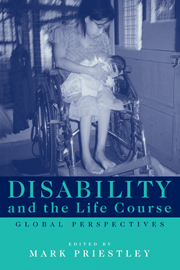Book contents
- Frontmatter
- Contents
- List of figures
- List of tables
- Notes on contributors
- Preface
- Acknowledgements
- A brief note on terminology
- I Concepts
- II Methods and stories
- III The politics of transition
- 13 Disabled children: an emergency submerged
- 14 Failing to make the transition? Theorising the ‘transition to adulthood’ for young disabled people
- 15 Breaking my head in the prime of my life: acquired disability in young adulthood
- 16 Work and adulthood: economic survival in the majority world
- 17 The possibility of choice: women with intellectual disabilities talk about having children
- 18 Ageing with disability in Japan
- 19 Ageing with intellectual disabilities; discovering disability with old age: same or different?
- 20 Epilogue
- Index
13 - Disabled children: an emergency submerged
Published online by Cambridge University Press: 30 September 2009
- Frontmatter
- Contents
- List of figures
- List of tables
- Notes on contributors
- Preface
- Acknowledgements
- A brief note on terminology
- I Concepts
- II Methods and stories
- III The politics of transition
- 13 Disabled children: an emergency submerged
- 14 Failing to make the transition? Theorising the ‘transition to adulthood’ for young disabled people
- 15 Breaking my head in the prime of my life: acquired disability in young adulthood
- 16 Work and adulthood: economic survival in the majority world
- 17 The possibility of choice: women with intellectual disabilities talk about having children
- 18 Ageing with disability in Japan
- 19 Ageing with intellectual disabilities; discovering disability with old age: same or different?
- 20 Epilogue
- Index
Summary
Noluthando is a strapping 16-year-old girl with severe cognitive impairments. She attends a day care centre in an informal settlement, where her mother cares for other children with similar impairments. Noluthando has been repeatedly raped within her community, but her perpetrators have never received any punishment for the crimes that they have committed against her. The reason for this is that she is perceived to be unable to give evidence in her defence. To a large extent, children like Noluthando have little access to the justice system, as they are regarded as unreliable witnesses.
Lisa was a six-year-old physically disabled child who used a wheel-chair. She lived in an informal settlement, consisting of cardboard homes under one of the many bridges that form part of the busy highways in Cape Town. A fire broke out within the settlement, and Lisa, forgotten in the pandemonium, was burnt to death because she could not escape in time, and because no one helped her.
Noluthando and Lisa are but two examples of the life experiences of disabled children living in South Africa, yet their particular situation resonates with the life experiences of many of their peers on the African continent. It is important to ask how disabled children's lives and life course pathways are influenced by changes in the society in which they live.
- Type
- Chapter
- Information
- Disability and the Life CourseGlobal Perspectives, pp. 151 - 166Publisher: Cambridge University PressPrint publication year: 2001
- 2
- Cited by



